Authors Note: This review is a combination of historical facts regarding the AR-10 in general and the Windham Weaponry R20FFTM-308 specifically. Because this is my first time within the MSR of .308 caliber, I thought that it would be interesting to include both. I hope that you agree. Also, I refer to MSR firearms as much as possible in the article. It is my belief, as with many others, that MSRs are Modern Sporting Rifles and not ‘Assault Rifles’ as some would want you to believe, and I try to do my part in dispelling that ‘AR’ stands for “Assault Rifle” to the novice or persons otherwise uneducated regarding the term. The term ‘AR’ is only used with reference to Armalite, wherever possible.
For Part 1 of this review, History and Back Story, click the image below.
The Basics:
- Model: R20FFTM-308
- Caliber: .308 Win.
- Type: Rifle
- Action: Semi-Automatic, Gas Impingement System
- Capacity: 5 + 1- Ships with one 5 Round Magazine
- Safety: Manual Lever with Indicator Markings on Both Sides of Receiver
- Receiver: Hard coat Black Anodize Finish
- Receiver Material: Forged 7075 T6 Aircraft Aluminum with Integral Trigger Guard
- Receiver Finish: Hard coat Black Anodize Finish
- Bolt Material: Carpenter 158 Steel
- Barrel: 20” Fluted, Chrome Lined with A2 Flash Suppressor
- Barrel Material: 4150M Chrome Moly Vanadium 11595E Steel
- Rifling: 1 Turn in 10” – Right Hand Twist – 6 Lands & Grooves
- Stock: Magpul MOE Fixed Buttstock
- Forend / Pistol Grip: Magpul MOE M-Lock Hand guard / Hogue Over-molded Grip
- Rear Sight: None – Ready for optics or other type accessory sights
- Front Sight: None – Mil Std 1913 Gas Block Rail – Ready for accessory sights
- Packaging: Hard Plastic Gun Case with Black Web Sling, Q.D. Sling Swivel & Operators Manual. Transferable Lifetime Warranty
- Weight: 9.05 Lbs. (Without magazine)
- Length: 40.75 inches
The rifle came with two of my favorite things; the MAGPUL MOE stock (more on that later) and the Hogue over-molded finger-groove grip. These are two things that are primary components and which other stocks and grips are replaced with on all my MSRs.
Bringing it Home
All Windham Weaponry MSRs are shipped in a hard-polymer padded case that also includes; a magazine, sling, a chamber flag, an excellent fully-illustrated Operating and Safety Manual in color, and Windham Weaponry catalog (includes parts).
With this particular variation, a QD front sling mount and rear sling mount (more on the stock sling mount later) was also included.
I will no longer be using the case for the R20FFTM-308, as the addition of a scope prevents the case from closing due to the mounting height of the scope. With only a normal set of sights mounted; however, the case could still be used. An ‘off-mount’ optic could accompany the rifle in the case, if desired.
Let’s start this review of the Windham Weaponry R20FFTM-308 itself at the front and work backward.
The Barrel
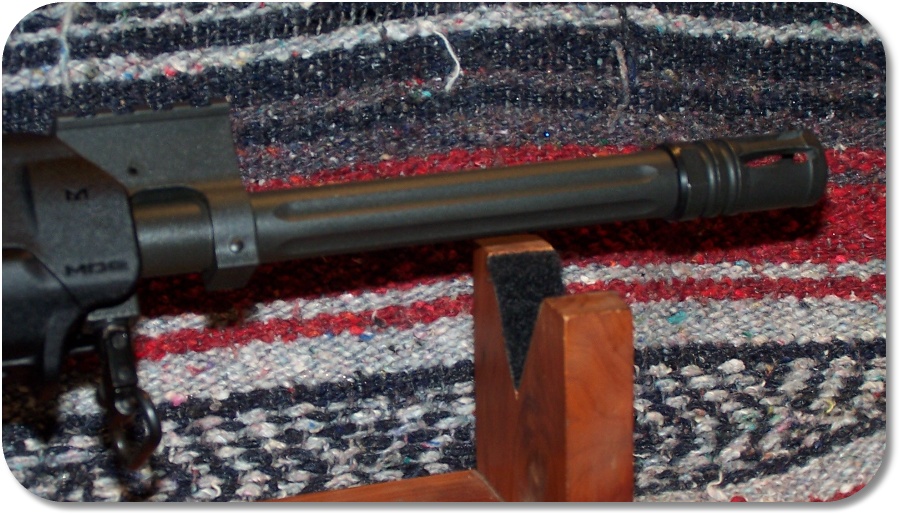
Fully-Fluted Barrel.
Since the gas block/front sight mount gets hot under fire, it is recommend that if back up sights are mounted, the front sight must be steel. The gas block/front sight mounts is a Mil Std 1913 Gas Block Rail. MAGPUL Pro sights are a perfect combination to mount, as I have on other MSRs. However, this rifle is destined to be “Optic” only (more on the selected optic later) and BUIS is not being considered by me.
The muzzle incorporates an A2-style birdcage flash suppressor that blends in well with the barrel, which is fully fluted up to the gas block and again forward of the gas bock/front sight mount. The barrel is clearly stamped with WW .308 1/10.
The 20” Fully-Fluted, 4150M Chrome Moly Vanadium, 11595E Steel barrel’s Manganese Phosphate Finish is excellent and evenly applied.
Beneath the gas bock/front sight mount is a provision for attaching a front sling mount that, by the way, was already attached. The sling mount is of the quick-detachment/attachment type, which I prefer over the fixed sling mount type, as I like my choice of sling mounting options. Windham Weaponry also has a spacer (not provided) that can be used with a bi-pod when attached to the front sling point. The QD sling mount is a nice feature.
The gas system is of the ‘direct impingement’ type. “The original AR-10 action (later developed into the ArmaLite AR-15 and M16 rifle) designed by Eugene Stoner is commonly called a direct impingement system, but it does not utilize a conventional direct impingement system. In U.S. Patent 2,951,424, the designer states: ″This invention is a true expanding gas system instead of the conventional impinging gas system.″ Gas is routed from a port in the barrel through a gas tube, directly to a chamber inside the bolt carrier. The bolt within the bolt carrier is fitted with piston rings to contain the gas. In effect, the bolt and carrier act as a gas piston and cylinder.” – Source: https://en.wikipedia.org/wiki/Direct_impingement.
More on this feature later.
The Hand Guard
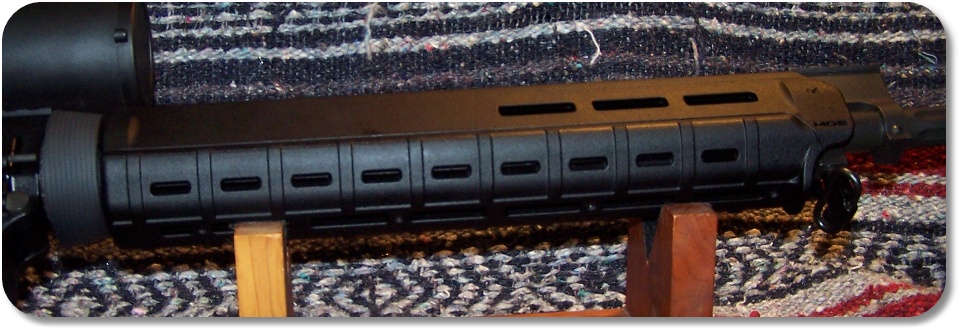
Very Nice MAGPPUL MOE® M-LOK® Hand Guard, Rifle-Length – AR15/M4, .
The hand guard is a MAGPPUL MOE® M-LOK® Hand Guard, Rifle-Length – AR15/M4, which ensures a firm hand hold while blending in perfectly with the MOE stock. The front end of the hand guard wraps ever so slightly around the gas bock/front sight mount that gives the front-end a well-blended, finished look. The lines of the stock and hand guard, while providing function, also provides a styling to the rifle that is very clean looking.
Features of the hand guard include:
- Easy to install utilizing existing delta ring and triangular or round front hand guard retaining cap
- M-LOK slots at the two, six, and ten o’clock positions for mounting MIL-STD-1913 Picatinny rails or other direct-attach M-LOK accessories
- Reinforced, heat-resistant polymer construction
- Integral riveted aluminum heat shield
- Front lip and side extensions, shields hand from hot gas block
- Relieved area at the top rear accommodates most overhanging optic mounts
You can hang whatever you want on this hand guard; lights, lasers, vertical or angled hand grips, Slim Jim tube, etc.
UPDATE 08/10/2020
While I like the handguard of the WW, I really like the feel of an angled grip. Two things were needed: a MAGPUL AFG® – Angled Fore Grip and a 13-Slot M-Lok Picatinny Rail to mount it with.
Below shows the result:
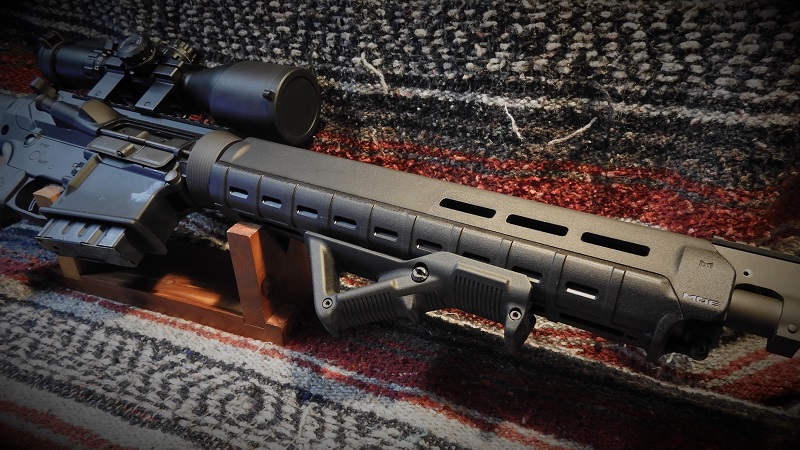
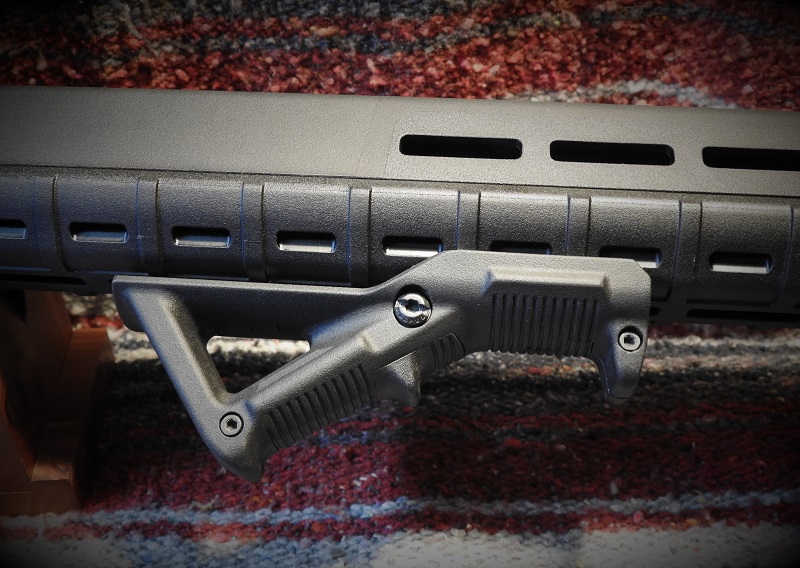
Technical Specifications
- Height, over rail: 1.75 in.
- Length: 5.55 in.
- Weight: 2.92 oz.
- Width, maximum: 1.77 in.
The front end, forward of the Delta Ring is excellent, and that means that it’s time to move to the Receiver.
The Receiver
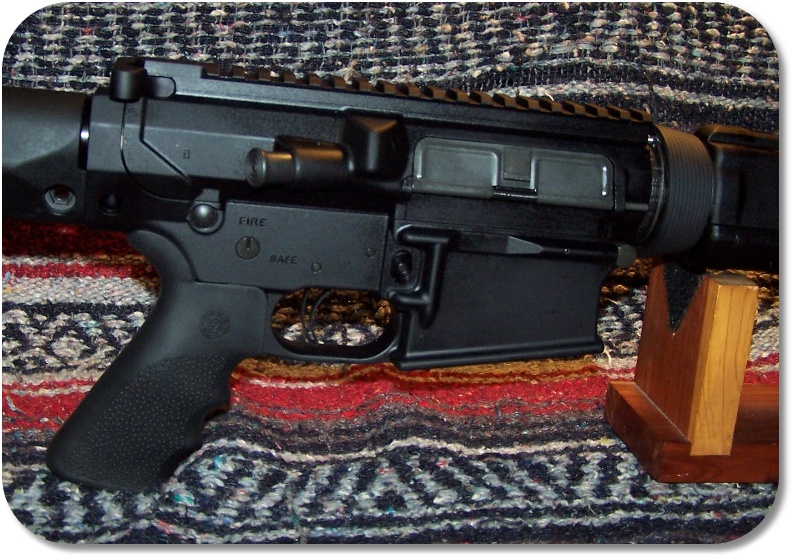
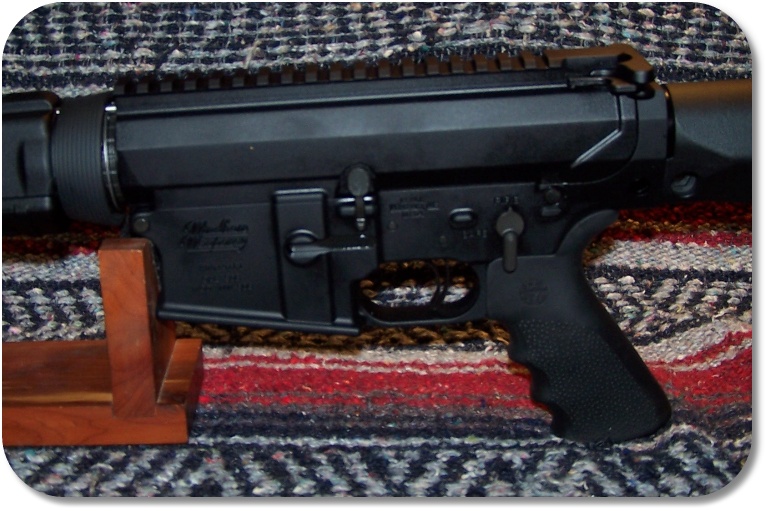 The Forged 7075 T6 Aircraft Aluminum with Integral Trigger Guard, Hard coat Black Anodize Finished receiver is just like that on my WW .223/5.56mm SRC and my WW 7.62x39mm SRC, except that it’s bigger, and has a non-removable trigger guard. The applied finish is excellent.
The Forged 7075 T6 Aircraft Aluminum with Integral Trigger Guard, Hard coat Black Anodize Finished receiver is just like that on my WW .223/5.56mm SRC and my WW 7.62x39mm SRC, except that it’s bigger, and has a non-removable trigger guard. The applied finish is excellent.
All controls (Safety lever, bolt release, and magazine release) are in the same place as any other MSR. The safety lever is not ambidextrous, but that is alright with me, because I have learned to manipulate the safety lever with my shooting finger, as I am a left-hand shooter of rifles long and carbines short.
The top of the receiver is a Mil Std 1913 rail that is long enough to adequately mount a BUIS and a choice of magnified or non-magnified optic.
As mentioned earlier, the grip is the Hogue Rubber finger-grooved grip that I thoroughly like to wrap my mitt around. I highly recommend them, as it fits larger hands, and its “beavertail back strap” fills the Lower Receiver to provide better padding for the webbing between the thumb and index finger with the slightly heavier recoil of the .308 cartridge. There are a number of 1911 pistols, and several revolvers, in my family that have this type of grip and the feel of the grip is very familiar.
The magazine well is well-suited to accept any AR-10 .308 magazine. A five-round, steel ASC magazine comes with the rifle (“The Windham Weaponry .308 is designed for big game at long ranges.”), but a purchase of ten-round, twenty-round, and a few more five-round magazines expand the capabilities of the rifle, along with a Lula loader for .308 magazines to extend the life span of my loading thumb.
The ASC magazine fits slightly loose when locked into place, but some looseness is a good thing, because you want the magazine to move as needed as the bolt is working back and forth. The magazine slides into the magwell easily and just as easily falls out when the magazine release button is pushed.
The dust cover operates as usual on these MSRs, as does the shell deflector and that is highly welcomed among left-hand shooters like me. Nobody likes being bonked by a hot, just ejected shell case. This dust cover, being new, was a little reluctant to flop down when the Carrier Assembly and Charging Handle were pulled to the rear. It would release from its position, but would not fully open. After a dab of Ballistol and some working the dust cover for a while, it began to operate as it should, but still hangs up on occasion.
A forward-assist button is also available for those who like this feature.
The lower receiver has machined sockets each side behind the pistol grip that are intended for Quick Detach sling swivels. This feature offers multiple sling attachment points on the receiver, in addition to that provided with the Magpul MOE stock.
Now that we have been outdoors, it is time to move indoors to the inner workings of the upper and lower receiver, because there is something special about this one.
The upper separates from the lower in usual MSR fashion.
Before I get into the innards, just let me say that pulling the charging handle to the rear will remind you that, although this rifle is a based on the AR platform, this is not as easy as pulling the charging handle back on your average MSR that is chambered for the .223/5.56mm cartridge. The recoil spring is hefty.
I shoot long guns left-handed (due to a right side body injury) and I cannot just wrap my right (strong) hand around the magazine well and reach the bolt lock lever, because the mag well is much longer than that of a MSR-15. I need to shift the rifle to my strong side, allowing the left hand to press the bolt lock as I pull rearward on the charging handle with my right, strong-side hand, if an empty magazine is not inserted. With a magazine inserted, I have no problem locking back the bolt with the charging handle with my weak-side hand (left). With that said, I will probably opt (at a later time) for an ambidextrous Charging Handle with extended handle to help me clear the scope bell. However, as the rifle is breaking in, I am finding that pulling the Charging Handle to the rear using my weak-hand is becoming easier. This is a personal issue and many of you will not be as affected as I am. In other words, this is not a fault with the rifle, but with the operator.
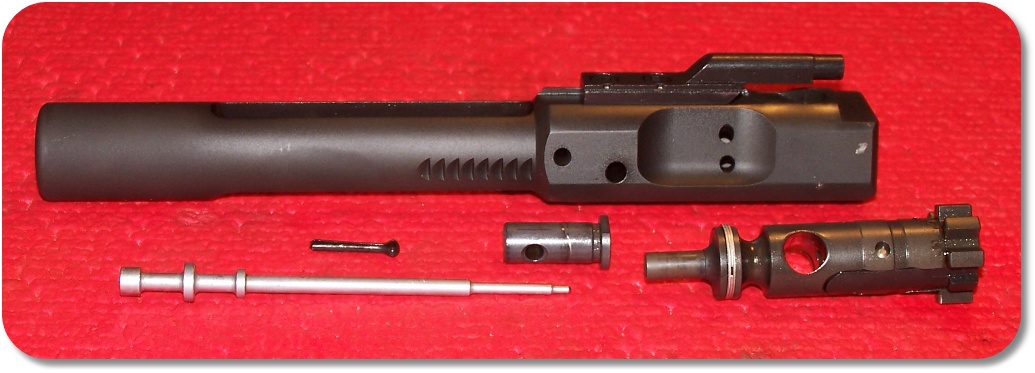
The Disassembled Bolt Carrier Group.
Removing the Bolt Carrier Assembly from the R20FFTM-308 is the same as with any MSR. The Bolt Carrier Assembly is; however, longer than what would be found on the .223/5.56mm version. But, I did find something interesting when the Bolt Carrier Assembly was disassembled.
The head of the Bolt Cam Pin, when removing it, just does clear the Bolt Carrier Key – but it does clear. For a moment I thought, “How in the heck did they get that thing in there, anyway?”
The Firing Pin Retaining Pin just seemed too short, to me. That led me to do some research, because I thought that this Bolt Carrier Assembly had been assembled with too short of a Firing Pin Retaining Pin. Before I embarrassed myself by sending an e-mail to Erik Winter at Windham Weaponry, I researched the part in the very fine, colorized and organized catalog that came with the rifle. It states that; “The Firing Pin Retaining Pin is the same used in the .223. I expected longer (that’s been said to me before), but as long as it does its job it’s alright by me. I don’t know why, but I would just feel better if the Firing Pin Retaining Pin was just a hair longer, as it does have a tendency to back out under fire, but can only back out so far.
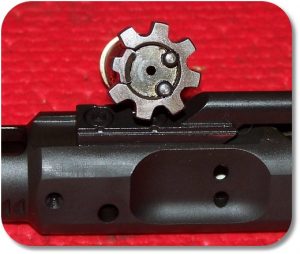 The Bolt Assembly comes well-lubed by the factory and I intend for it to stay that way. The Bolt Gas Rings were properly spaced.
The Bolt Assembly comes well-lubed by the factory and I intend for it to stay that way. The Bolt Gas Rings were properly spaced.
The bolt is larger for the .308 cartridge and has dual ejectors for more reliable and positive case ejection, as seen in the left photo.
The Bolt Carrier Key (Gas Key) is properly staked. Everything, that I can tell, is on the up-an’-up with the Bolt Carrier Assembly.
The firing pin for the .308 version is slightly longer than standard pins for better 7.62 primer detonation and, incidentally, and is noticeably longer than the firing pin used in my 7.62×39 “SRC.”
Looking at the parts that help to buffer things and make the bolt operate properly, the R20FFTM-308 has the MAGPUL MOE Fixed Stock and that means that it uses a “Rifle-Length” standard Buffer Tube and Rifle Buffer spring for .308. The Buffer Tube is high-quality aluminum with solid weights.
Now, about that ‘Special Thing’ that I mentioned earlier in the article. That special thing is the trigger.
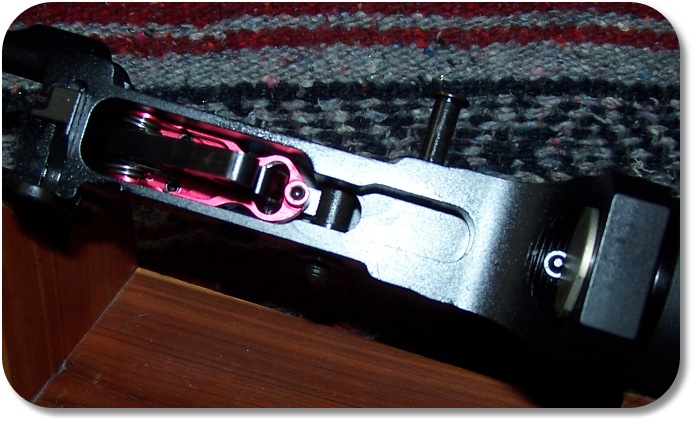
Elftman Drop-In Single Stage Match Trigger for .308/AR10 rifles.
Looking down into the receiver there is this red assembly that you don’t find on production MSRs (normally). This trigger unit is an Elftman Drop-In Single Stage Match Trigger for .308/AR10 rifles, and it is an absolute dream to pull. This unit can be adjusted from 2.75 Lbs. to 4 Lbs. and came factory set at 3 Lbs. There is absolutely no take-up or over-travel. I had ordered the rifle with the trigger factory-installed, and before I take you too far in this article, I have written a separate review on the Elftman Drop-In Single Stage Match Trigger @ https://guntoters.com/blog/2018/09/30/elftmann-drop-in-single-stage-match-trigger/.
Of course, the Upper to lower installation is the same as any MSR. With this particular rifle, an ‘Accuwedge’ is not necessary. The upper-to-lower fit is tight with no play to speak of, and I doubt that using an Accuwedge would be an improvement.
The Stock
The stock is a MOE® Rifle Stock.
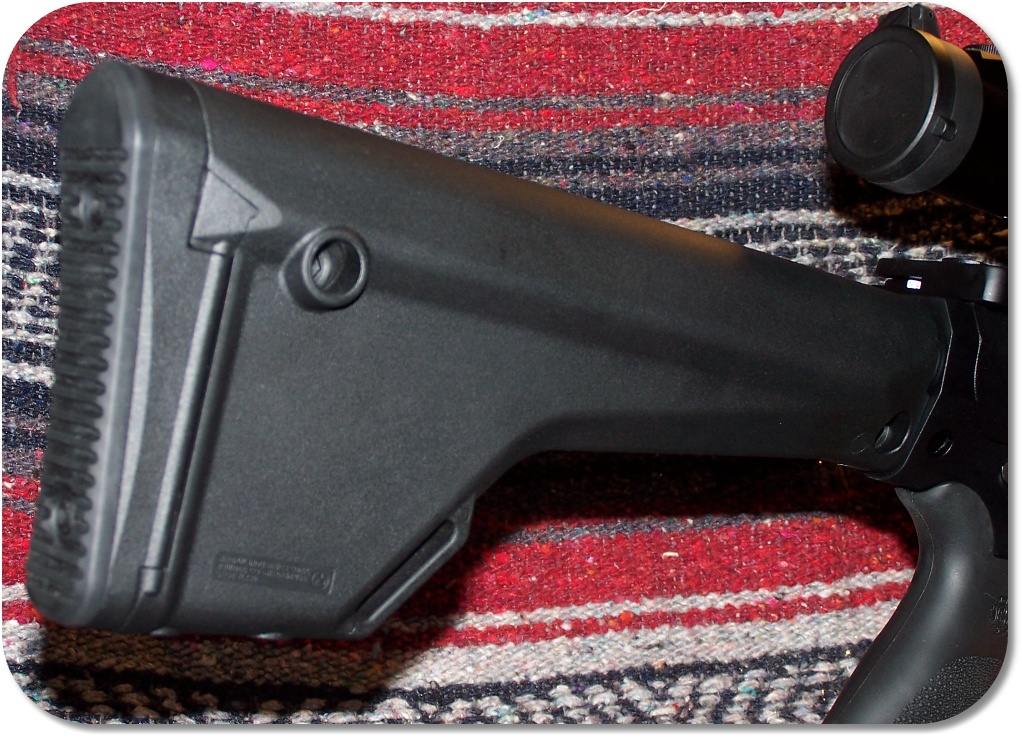
FEATURES
- Mounts to rifle-length receiver extension tube without A2 spacer (not included)
- Sloping cheek weld combines a slim profile with user comfort
- Overall shape provides for offhand hold options
- Rubber butt-pad provides positive shoulder purchase to prevent slippage
- Large storage compartment easily accessible behind hinged butt-plate (for Slim Jim Sticks?)
- Knockout bosses on the bottom allow for the addition of an optional accessory rail (up to four individual sling mounts can be configured with the Magpul Type 1 Sling Mount and Type 2 Sling Mount combination)
- Sling Mounts
- Bottom Rear – 1.25″ Sling loop
- Front/Rear – Optional Sling Mounts fit up to 1.5″ push-button QD swivels
- Weight, Stock: 14.0 oz.
- Weight, w/rifle receiver extension: 17.6 oz.
- Length: 10.4″
- LOP: ~13.5″
Overall, the stock provides a 14” LOP that, to me, is almost perfect, but the stock butt pad will be changed out with a MAGPUL Enhanced Rubber Butt-Pad, 0.70″ to provide me with my desired LOP.
A sling mounting kit (Magpul Type 2) for the MAGPUL stock did come with the R20FFTM-308. However, the mounting screws and lock nut did not. But, that is normal for the Type 2 Sling Mount, as it is used in conjunction with the Type 1 Sling mount, because the Type 2 is installed on the opposite side to the Type 1 and adds an additional push-button QD Sling Swivel. The Type 1 sling mount comes with mounting hardware. The Type 2 actually replaces the locking nut that comes with the Type 1 sling mount. The correct sling mount has been ordered. Now, about that sling!
The sling is adequate, for the most part, to haul a MSR like my R16M4FTT (.223 Rem /5.56mm NATO @ 6.30 Lbs. (w/o magazine) “SRC,” or the even lighter R16M4FTT-762 (7.62x39mm SRC) at 6.15 Lbs. (w/o magazine). However, add 1.6 pounds of scope to a 9.05 pound rifle, a fully-stocked magazine, and possibly a bi-pod, you are then carrying possibly eleven pounds of fire power, and that takes a stout support strap. For the most of us, we will end up purchasing a sling that suits our needs, but I thank Windham Weaponry for providing one, nonetheless.
Range Prep
After the R20FFTM-308 was properly cleaned and lubed, it was time for some range testing. But, first I have to talk about the selected optic, as the R20FFTM-308 has neither sights nor optic mounted out of the case.
Optics:
As mentioned earlier, the Windham Weaponry R20FFTM-308 is “Sight Ready” and the choice of sights and optics are up to the owner.
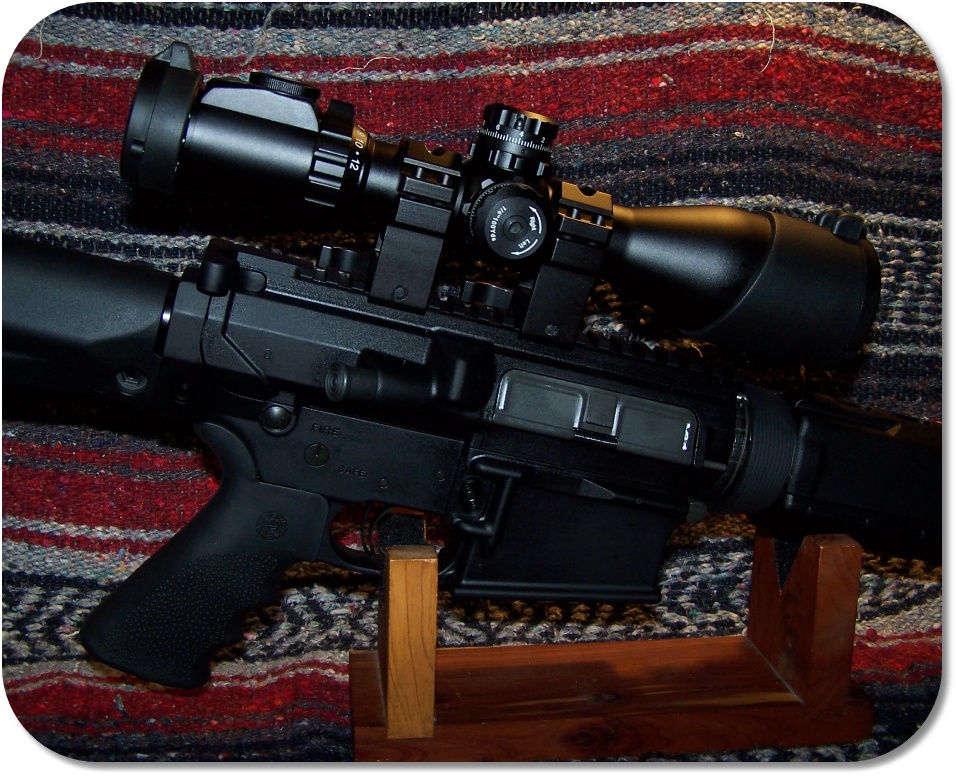
UTG 3-12X44 30mm Compact Scope, AO, 36-color Mil-dot.
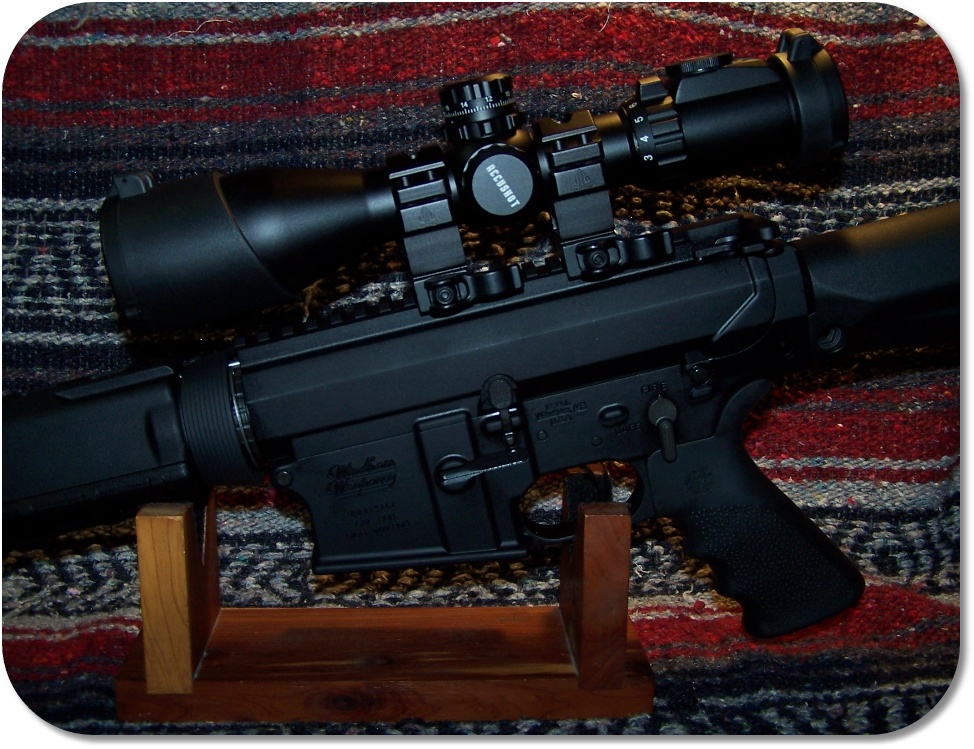
UTG 3-12X44 30mm Compact Scope, AO, 36-color Mil-dot.
Since I had a UTG 3-12X44 30mm Compact Scope, AO, 36-color Mil-dot, Rings (https://www.amazon.com/UTG-3-12X44-Compact-36-color-Mil-dot/dp/B004KRA4YG/ref=sr_1_5?ie=UTF8&qid=1538146854&sr=8-5&keywords=UTG+scope) that was mounted in UTG 30mm/2PCs Hi Pro LE Grade Picatinny QD Rings: 22mm Wide (https://www.amazon.com/UTG-30mm-Grade-Picatinny-Rings/dp/B004HIJCWS/ref=sr_1_6?ie=UTF8&qid=1538146937&sr=8-6&keywords=UTG+scope+rings) left over from a previous project, I thought why not try it. (Incidentally, read my review on this scope @ https://guntoters.com/blog/2018/03/23/leapers-utg-3-12×44-30mm-compact-tactical-rifle-scope-ao-36-color/).
This seems to be a rigid setup that will handle the recoil of.308 Winchester cartridges, and it looks right at home on the rifle.
A dab of grease on the locking lugs, a dab of blue thread locker on the retention screws, tighten the locking handles, and off to the range we go.
Range Day
I have to admit that I do not shoot .308 cartridges often. When I do, one of the bolt guns usually come out to play. I do have a Springfield M1A, but it has not yet yearned to be shot. The R20FFTM-308 would be my first encounter with a semi-automatic in .308, since I cannot count the M14 that was shot during military duty, as that was with 7.62x51mm NATO ammunition.
I had four choices:
- A near-full box of Winchester Razorback XT, 150-grain Beveled Profile Protected Hollow Point that had a rated velocity of 2810 fps.
- Georgia Arms, 168-grain BTHP Winchester Match Grade ammunition with a rated 2600 fps.
- The third choice was Winchester 150-grain Super X Power-Point @ 2820 fps.
- The final choice (as if I had one) was Monarch 150-grain Soft Point (Brass) @ a rated 2820 fps, which is made by Sellier and Bellot for Academy Sports.
The second choice was the first choice to begin with, as I wanted to find out how a new rifle would react to ‘match ammunition’ of a lower velocity than that used for hunting or ‘special’ applications. And, the first order of the range day was to zero the scope, which would have to be at 25 yards since that is the furthest distance at my indoor range. Obviously, I would not be measuring the full potential of this rifle until I could get to an outdoor range with some distance, but you have to start somewhere. And, a twenty-five yard zero is good enough for “combat” accuracy at far greater distances.
According to http://spoton.nikonsportoptics.com/spoton/spoton.html#Index:11, I could zero -0.68” below center for a 100 yard zero with the set-up that I had. Since I was basically concerned, at this time, about function over form I simply went for zero at 25 yards. The rest would come later.
Only one 5-round magazine came with the rifle, and that was fine with me. I was, after all, breaking in a new rifle with a new barrel and a new trigger – slow is good in this case. Additional (greater capacity) magazines are on order, but I actually like the five-round magazines for range work and keep higher capacity magazines for, well, high-capacity magazine work.
Now, I have to tell you about a concern of mine. The ejection port of the Windham Weaponry R20FFTM-308 is like any other MSR; it is on the right side of the receiver. Like all direct impingement systems, there is a lot of debris (other than expended cases) that can be expelled from the ejection port. While not a concern for most shooters, who are right-handed, it can be a concern for us left-handed shooters. In truth, I have not had any problems with MSRs chambered in .223/5.56 NATO or the 7.62x39mm versions with regard to what comes out of the ejection port. The caliber .308 is; however, a more powerful cartridge than those mentioned, and with safety always being a concern of mine, I did have a slight hesitancy to fire this rifle. After a few shots; however, that hesitancy went away. The bullet went in the right direction as did the expended cartridge – and they do eject with authority.
The Windham Weaponry R20FFTM-308 is an absolute joy to shoot, even with high-velocity hunting ammunition. The recoil is much lighter than I expected and is much lighter than shooting the same ammunition with any of my bolt guns. I let one of my shooting companions shoot the R20FFTM-308, who had never shot an AR-10-based rifle, and had asked me how the recoil was. He does own a MSR-15, and I let him get behind the rifle and told him to experience it himself. He shot three rounds and conceded the recoil is much more than with a .223 Remington cartridge. I just smiled. The recoil is there, but it is not going to abuse you.
He had shot three rounds, placed it on safe, leaving one in the chamber and one in the magazine. I decided to see how the R20FFTM-308 would operate with 5+1 rounds. I didn’t expect an issue and there wasn’t any; the R20FFTM-308 performed flawlessly.
The experience of shooting the Windham Weaponry R20FFTM-308 was, of course, enhanced with the Elftman Drop-In Single Stage Match Trigger for .308/AR10 rifles. I could concentrate on the shot and not on the pulling the trigger, as I have to with a standard MSR trigger (read my review of this fine trigger @ https://guntoters.com/blog/2018/09/30/elftmann-drop-in-single-stage-match-trigger/.
I did have one FTF with the last round in the magazine of the ‘match’ ammunition in the first magazine fired. But, I attributed this to a new rifle, with a new magazine, and a light load. There were no failures at all with the rest of the ammunition shot, including the match ammunition. The R20FFTM-308 ran like the well-oiled machine that it was.
As far as accuracy, the Windham Weaponry R20FFTM-308 can hold its own. The last 6 rounds fired filled a ½” group with two bullets sharing the same hole. Now, 25 yards is no real test for accuracy, but all indications are that with a capable shooter behind the rifle and good ammunition, the Windham Weaponry R20FFTM-308 is more than capable of delivering the goods on targets well distant to what I was shooting at.
After the session was over I turned my friends who had all shot the Windham Weaponry R20FFTM-308, and asked them, “Well, do you think that it is worth keeping?” To a man, they all nodded their heads to the affirmative.
The Wrap-Up
I would like to say that the Windham Weaponry R20FFTM-308 has exceeded my expectations – so I will; “The Windham Weaponry R20FFTM-308 has exceeded my expectations.” The Windham Weaponry R20FFTM-308 was received as a T&E rifle. It is; however, destined to become part of the family, and I can say that without hesitation.
While there are many AR-platform-based MSRs in caliber .308 on the market, the Windham Weaponry variations in the direct-impingement class of MSRs offer an excellent product with an excellent cost/benefit ratio.
I like the clean lines and looks of the Windham Weaponry R20FFTM-308 that can be kept as such, or modified to include needed or wanted accessories of the heart’s desire.
In truth, I can find more fault with the reviewer with his ranting reviews than I can with the Windham Weaponry R20FFTM-308.
The .308 Winchester is one of the most popular large-game hunting cartridges in the United States, possibly exceeding the .30-30. The Windham Weaponry R20FFTM-308 is quite capable of sending plenty of .308 bullets downrange in short order.
It does make me wonder; however, if the AR-10 had been accepted to replace the M1 Garand in the trials of 1956, would the AR-15/M16 have been developed? I do believe so, because of the need for the average soldier to carry a lighter weapon with more cartridges than what was capable with the M14. And, there was a need in 1964, with the U.S. military service deployment into jungle warfare operations during the Vietnam War for this type of weapon. In 1969, the M16A1 replaced the M14 rifle. The M16A1 improvements included a bolt-assist, chrome-plated bore, and a 30-round magazine over the original M16. And, there was the civilian market to consider, who seem to like ‘military-style’ firearms and the AR-15 semi-automatic firearm (I prefer to use MSR-15) fits that like. The MSR-10 may not enjoy the popularity of the MSR-15, but it is a very versatile firearm used for hunting, sport shooting, and professional ‘needs.’
The Windham Weaponry R20FFTM-308 is just one fine example of the MSR-10 platform. If you are considering a MSR-10, you just might want to consider looking into the Windham Weaponry line-up of caliber .308 rifles and carbines.
Decisions, Decisions, Decisions
As I mentioned in Part 1, History and Back Story, of this review, the Windham Weaponry R20FFTM-308 is a T&E (Test and Evaluation) rifle. Now I know what ‘professional’ reviewers like SOOTCH00 and Hickok45 go through when they receive T&E firearms; deciding to send the T&E firearm back or adding it to the family. Now, the decision was left up to me.
In the immortal words of Ten Bears (The Outlaw Josie Wales), “It is good that warriors such as we meet in the struggle of life… or death. It shall be life.”
Update 10/02/2018:
I received in the spare magazines (5-round, 10-round, and 20-round) that were ordered from Windham Weaponry and will be running those in the next few weeks for test and evaluation.
Some PPU 308 Winchester PSP BT 165-grain fodder also came in that provides a few more rounds for testing.
In addition, the Magpul MOE SL Enhanced Butt pad (0.70-inch) has been installed to provide me with a bit more LOP.
Pending arrival from Windham Weaponry is a Bolt & Carrier Carbon Scraping Multi-Tool for 7.62 and a GI Military Style Cleaning Kit for .308 Rifles, which can be used on the WIndham Weaponry R16M4FTT-762 (7.62x39mm SRC) and the R20FFTM-308. These are great cleaning kits and I have one for the .223/5.56mm NATO MSRs.
I’ll post further updates as I move along into the MSR-10 adventure.
Resources:
- Windham Weaponry: https://www.windhamweaponry.com/
- Windham Weaponry – 308 Guide: https://www.windhamweaponry.com/customer-service/windham-weaponry-308-guide/
- Windham Weaponry R20FFTM-308: https://www.windhamweaponry.com/firearms/rifles/308-caliber-rifle/r20fftm-308-2/
- MAGPUL AFG® – Angled Fore Grip: https://magpul.com/afg-angled-fore-grip.html?mp_global_color=118
- GoldCam M-Lok Picatinny Rail, 13-Slot 7-Slot 5-Slot Mlok Aluminum Picatinny Rails Section for M LOK Systems with 7 T-Nuts & 7 Screws & 3 Allen Wrench, 3 Pack – Black: https://www.amazon.com/gp/product/B07RZFQ5DG/ref=ppx_yo_dt_b_asin_title_o00_s01?ie=UTF8&psc=1
![]()


